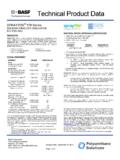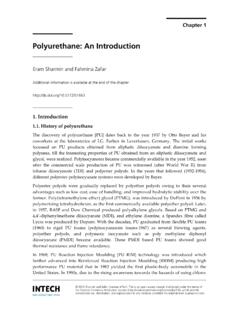Transcription of Table of Contents - BASF Polyurethanes
1 1 Table of Contents 1. Emergency Contact Numbers .. 2 2. Introduction .. 3 3. MDI Products .. 5 MDI Production Process .. 5 MDI Product Family, Properties, and Applications .. 6 4. Health Considerations .. 9 Acute Hazards .. 9 Effects on Respiratory System .. 9 Effects on Eyes, Skin and Ingestion .. 10 Chronic Hazards .. 10 Sensitization .. 10 First Aid .. 10 Medical Considerations .. 11 Industrial Hygiene .. 11 5. Safe Handling of MDI Products .. 13 Employee Training and 13 Engineering Considerations .. 13 Personal Protective Equipment .. 14 Fire Hazards .. 15 6. Shipment of MDI Products .. 16 Regulations .. 16 Shipping Containers .. 16 Unloading Operations .. 17 Bulk Unloading .. 17 Drum Handling .. 17 Sample Shipments.
2 17 7. Storage .. 19 Storage and Handling Considerations .. 19 Storage Tank Design .. 19 Container Storage .. 20 8. Emergency Procedures .. 21 Guidelines for Dealing with MDI Product Incidents .. 21 Spills and Leaks .. 21 MDI Involved in Fires .. 22 Pressurized Drums .. 23 Chemical Reactions .. 23 9. Environmental Considerations .. 24 Disposal of Waste MDI Products .. 24 Decontamination and Disposal of Used 24 Ecological Effects .. 25 10. Frequently Asked Questions .. 26 11. References .. 30 12. Other Considerations .. 32 2 1. Emergency Contact Numbers United States CHEMTREC ---------------------------------------- ---------------------------------------- ------------------------- 1-800-424-9300 Human Poison Control Center ---------------------------------------- ---------------------------------------- -- 1-800-222-1222 Animal Poison Control Center ---------------------------------------- ---------------------------------------- -- 1-800-345-4735 National Response Center ---------------------------------------- ---------------------------------------- ------- 1-800-424-8802 BASF Emergency Response ---------------------------------------- ---------------------------------------- -- 1-800-832-4357 Canada
3 ---------------------------------------- ---------------------------------------- ---------------------------------------- ------------- CANUTEC (Emergencies) ---------------------------------------- ---------------------------------------- ------- 1-613-996-6666 (Non-Emergencies) ---------------------------------------- ---------------------------------------- ----------- 1-613-992-4624 BASF Emergency Response ---------------------------------------- ---------------------------------------- -- 1-800-832-4357 Mexico SETIQ (Emergencies) ---------------------------------------- ---------------------------------------- -----------01-800-00-214-00 CENACOM (Emergencies) ---------------------------------------- ---------------------------------------- ----01-800-00-413-00 Polioles Emergency Response ---------------------------------------- ------------------------------- 011-52-722-265 8600 3 2.
4 Introduction diphenylmethane diisocyanate (MDI) is a member of the diisocyanate family associated with polyurethane chemistry. The term polyurethane applies to a large number of polymers formed through the polyaddition of polyfunctional isocyanates and isocyanate-reactive polyfunctional compounds. Polyurethanes are some of the most versatile polymers in existence today. They exist in numerous forms, ranging from lightweight rigid foams to dense solid compositions, and from soft flexible foams to tough elastomeric moldings. BASF Commitment to the Polyurethane Industry The worldwide polyurethane operations of the BASF Group include a broad range of activities such as: Urethane chemicals o diphenylmethane diisocyanate (MDI) o Toluene diisocyanate (TDI) o Polyols (polyether, polyester) Polyurethane systems Polyurethane elastomers / thermoplastics Microcellular Polyurethanes These activities are coordinated on a global basis to assure a high level of quality to polyurethane processors and users throughout the world.
5 Since its founding in 1865, BASF SE has placed major emphasis on research and development. Today, the results of widely based research activities in Europe and North America are directly available to all independently operating companies in the BASF Group. This constant interchange of technical expertise among businesses in the BASF Group ensures that BASF customers will benefit from the very latest know-how of polyurethane technology within the Group. Figure 1 illustrates the worldwide geographic spread of BASF Group products. Figure 1. BASF Urethane Chemical Production Sites. 4 BASF manufactures and markets three of the key urethane chemicals: MDI, TDI, and Polyols. MDI is produced in Geismar, LA, ; Antwerp, Belguim; Shanghai and Chongqing, China; and Yeosu, Korea.
6 These facilities produce a full line of MDI products, marketed under the trademark Lupranate to supply a wide range of polymer applications. Like many reactive chemicals, MDI products1 can create hazards if handled carelessly. The purpose of this publication is to outline precautions for the proper handling of diisocyanates under normal and emergency situations. All persons associated with the transportation, storage, or handling of MDI must be thoroughly familiar with the potential hazards and trained in the recommended standard and emergency handling procedures. This publication is intended only to provide general guidance, and for the area of North America. In some countries, specific regulations supplement or modify the guidance given herein.
7 All users of MDI products must be fully informed on the most current guidelines and regulations of all applicable authorities. Users of MDI are strongly urged to consult the appropriate regulatory authorities before finalizing specifications for processing, handling, and storage equipment. Any technical advice furnished, or recommendation made herein is believed to be reliable but BASF makes no warranty, either expressed or implied, as to its accuracy or completeness or of the results to be obtained. The current safety data sheet (SDS) should be used in conjunction with this publication because the SDS is updated as changes in regulatory requirements occur. SDSs can be obtained online ( ) or directly from your BASF representative.
8 1 In this handbook, the term MDI products is often used interchangeably with terms such as MDI , MDI-containing products , and MDI materials . 5 3. MDI Products MDI Production Process In the MDI process, aniline is condensed with formaldehyde to produce methylenedianiline (MDA), and MDA is reacted with phosgene to form MDI. The flexibility of the BASF process makes it possible to control and modify the properties of a broad range of MDI products. This process is designed with the flexibility that allows BASF to be a reliable source of MDI for the polyurethane industry. Figure 2 gives a summary of the MDI, TDI, and polyether polyol production processes. Figure 2.
9 Process summary for the production of polyurethane building blocks. Figure 3 shows the molecular structure of the primary MDI molecules: Polymeric MDI (PMDI) and Monomeric MDI (MMDI). Monomeric MDI Polymeric MDI Figure 3. Molecular structure of monomeric and polymeric MDI Product Family, Properties, and Applications MDI is available in three basic types of compositions: PMDI, MMDI, and Modified MDI. MDI and its modified forms are reactive chemicals supplied as liquids or solids. In combination with polyols (polyester or polyether), they are used for the manufacture of cellular (foamed) and non-cellular (compact) polyurethane polymers including textiles, coatings, adhesives, sealants, and elastomers (CASE).
10 BASF MDI Products can be used in many applications within CASE and other markets. PMDI PMDI is a brown liquid, stable over a wide range of temperatures. It contains a mixture of polyaromatic isocyanates including 2-ring (MMDI), 3-ring, and higher molecular weight species. As the amount of 3-ring and higher molecular weight species increase, the functionality and viscosity of the PMDI will also increase. PMDI products have a density of approximately g/cm3 at 77 F (25 C). PMDI starts to decompose at temperatures above 446 F (230 C) with the evolution of carbon dioxide (CO2). At 77 F (25 C), it has a low vapor pressure of 10-5 mbar ( mm Hg). PMDI is considered to have a low flammability risk due to its high flash point of over 392 F (200 C).

